CHIANTI & SIENA
Although I had registered as a Hertz No. 1 Gold Europe Preferred Member,
the agency would not deliver the car to us at the hotel, and we had to
take a cab to Hertz in downtown Florence. Of course, the CEO of Hertz International
will be receiving a Letter From Farklempt.
The prospect of leaving Florence in a car was something we dreaded,
but it wasn't bad at all. You just drive as fast as you can. The road signage
is surprisingly excellent, throughout Italy. To get to the center of a
town, you just follow the signs with a target on them. To leave a town,
you follow the signs that say "a tutti diretzione."
We took the Chianti road, winding through the hills of Chianti, rolling
hills that can become rather steep and long, a two-lane road with many
hairpin turns, often without guardrails. I loved it, while Carol hung on
with white knuckles and gritted teeth.
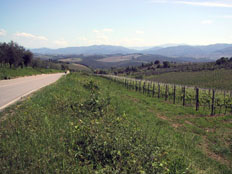
There was very little traffic. Lots of bicyclists, all on road bikes,
all wearing tight lycra silks without helmets. I was astonished at how
easily they could climb two-mile long steep hills, staying in the saddle,
not looking the least bit strained, without a granny gear. In my prime,
when I was an excellent and strong biker, I could never have made those
hills. We had a Renault midsize with a 5-speed shift. I love French cars--they
have that soft cushioned ride that is unmatched by any others, a bit spongy,
but still surprisingly nimble. the seats are high, beautifully constructed,
and the most comfortable in the business. I remember my old Peugeot so
fondly. If they only sold them in America, I'd buy one in a minute and
get over my krautophilia. The scenery was gorgeous, the trees and flowers
were in bloom, a honeysuckle-like scent bringing on sigh after sigh. Waves
of bright red poppies in rolling fields of green. We stopped in Montefioralle,
a tiny hilltop circular town, birthplace of Amerigo Vespucci, built as
an defensive outpost to protect Siena from marauding Fiorentinos.
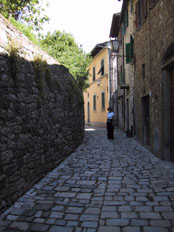
We drove to San Gimignano,
the picture-book hilltop town, filled with tourists, but with lots of room.
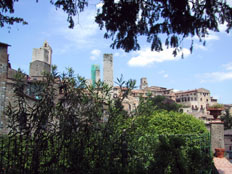 ..
..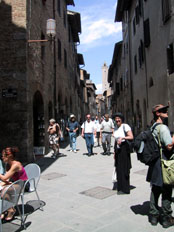
San Gimignano was the inspiration for Puccini's Suor Angelica. Much
climbing and walking, but the boots were holding up. We had a wonderful
lunch at the top of the hill at Osteria
delle Catene,small and quiet. We had a fabulous mezzolitro of Chianti,
as always acqua minerale frizzante,medieval soup made with saffron,
a critical item in the medieval economy of San Gimignano, pasta with pumpkin
sauce, and an antipasto. Then we drove to Monteriggiano, an ancient Roman
fortress town, built to protect Siena from invaders.
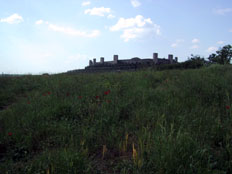 ..
..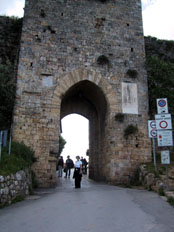 ..
..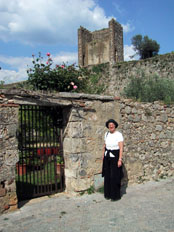
We drove to the Hotel
Castagneto in the outskirts of Siena, situated in an olive grove, looking
across to the skyline of Siena. We were welcomed by the Frangioli brothers,
Franco and Lorenzo, look-alikes for Uncle Junior Soprano. We got to talking,
my Italian having picked up a bit by now, and it turns out that they have
a cousin in Westerly, Rhode Island, Anna Giulia Gruccia. During World War
II, an American aviator bailed out over Siena and parachuted onto the property
of the Francioni family. Anna Giulia's father hid him away from the Germans.
When the war was over, he went home and returned to wed Anna Giulia at
a great ceremony in town, taking her back with him to Westerly as the first
American war bride. He gave me her phone number, and I called her when
I got home and e-mailed her Lorenzo's photo at the desk.
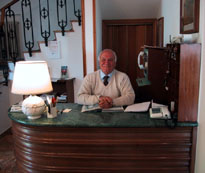
Our room ($70/night) was large, clean, and comfortable, with a stunning
view of the city.
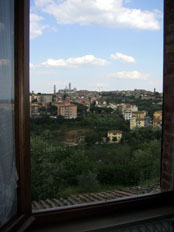 ..
..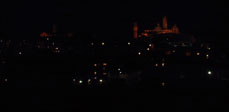
We tried to find out if Shabbat services would be held the following
morning at the synagogue of Siena, but the phone was answered by a machine.
We asked Franco, who started calling Jews in town (there are 50). He was
very distressed that Jews don't go to their own church, as he went to his
every Sunday. We parked just outside the wall of the city (most towns do
not allow parking inside), and were guided into the city by a lovely couple
just finishing high school.
Siena is much less formal than Florence. Florence closes down early,
but Siena is a party town, more casual, less high-style. Everyone seems
to know everyone else. The neighborhoods form contradi,which are
social, quasi-religious, sports clubs, each with its own coat-of-arms and
marching band.
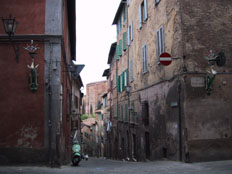
Twice a year, the contradi compete in Il Palio,a go-for-broke
horserace around Il Campo,the large central plaza. The Paliobegan
centuries ago as a headlong rush by members of the
contrati against
each other, using poleaxes and truncheons. Today, it is a more civilized
horserace, marked by attempts to abduct the opposing jockeys the night
before, attempting to fix the race in any way possible.
We ended up at a restaurant recommended by Nino, La
Chiacchiera,which means "the chatterbox." We had a reservation,
and they put us at a table for four. A few minutes later, they seated two
men at our table. One was younger, with the classic Tuscan look--long thin
face, dark hair, long straight nose, and prominent eyes. He could have
stepped out of any of the paintings we had seen over the past few days.
We had a pitcher of red wine, acqua minerale frizzante,ravioli with
zucchini, and a fabulous dish of tripe, one of the great dishes I have
ever eaten. You heard it right: tripe, or as they say trippe.I had
ordered tripe once before, thirty years ago at La Côte Basquein
New York. I had read that Jackie O. used to go in there and order Tripe
à la mode de Caën,so I thought I should try it. They brought
me a large bowl of intestines floating in a red gravy that looked like
it had been brought directly from the autopsy room at Bellevue. I couldn't
touch it. I made such a face that the waiter, a man of great kindness,
said, "This happens all the time, sir," took it away, and brought me something
else. But here, it was the hallmark of Sienese cuisine, and I had to try
again. The pieces were sliced up thin, so that you couldn't tell what they
actually were. They were tender, delectable, and the sauce, spicy with
garlic and truffles, was out of this world. Our tablemates egged me on,
urging me to add molto formaggio e pepe(Parmesan cheese and dried
red hot peppers). I threw the stuff on with abandon, crying out, like Tosca,
Muori!
Muori!"For dessert, we had vin santo(a trademark Tuscan fortified
sweet wine, that is like sherry, a bit too oxidized for my taste) and cantucci,small
almond biscuits (mandelbrøt).At the end of dinner, we were
quite sloshed, and considered ourselves lucky to have found our car again.
We knew it was in a parking lot near a large statue of a horse, and we
kept asking people we met, "Scusi, ma dove ha un cavallo?"--"Excuse
me, but where is there a horse?" We got a lot of strange stares.
On to Siena, Day 2 & Umbria
Back to previous page
Home


 ..
..
 ..
.. ..
..

 ..
..
